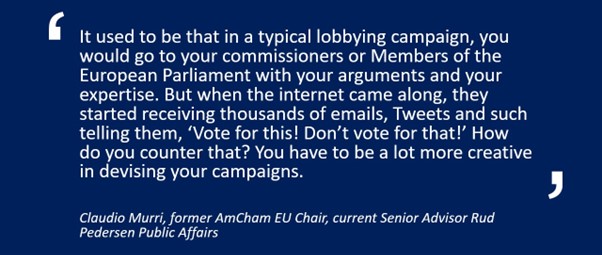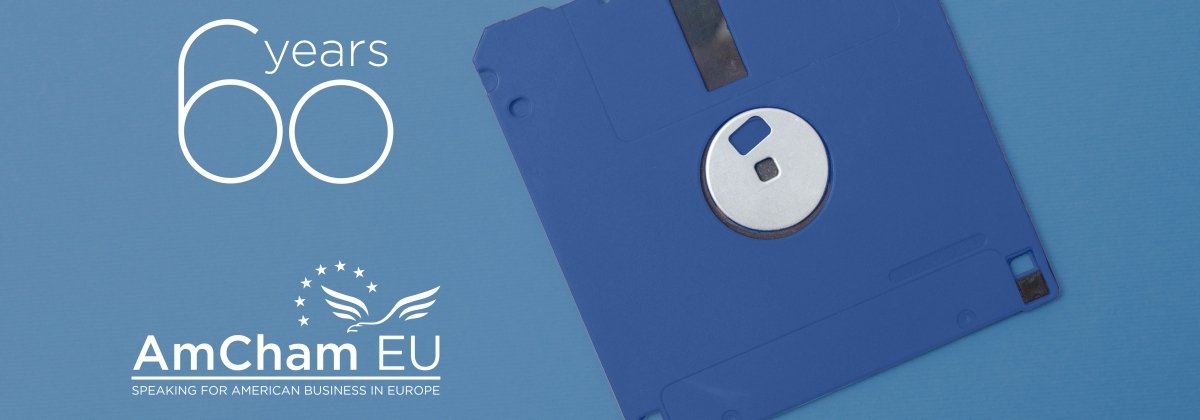When members of the American Chamber of Commerce to the EU’s (AmCham EU) forerunner, the Common Market Panel, met for the first time in 1962, they sat face to face and recorded meeting minutes with pen and paper. They had likely learned about current events by reading a newspaper earlier that day, and if they’d made a phone call, they would have dialled the number on a rotary phone.
Nearly every facet of life has changed drastically over the last 60 years, and nowhere is that evolution starker than when it comes to technology. As just one example, the rocket that took humans to the moon in 1969 had only 1.5% of the computing power as the phones in our pockets today. The staggering developments in the last half century have made the world both smaller and larger, by more easily connecting us to people in faraway places but also by broadening our horizons.
Since 1962, AmCham EU and its capabilities have grown hand-in-hand with technology. Today, the organisation is more efficient than ever before, in part thanks to instantaneous communication with stakeholders on both sides of the Atlantic. As advancements have become integrated into the workplace, developments in five technologies in particular – personal computers, email, internet, social media and video conferencing – have enabled members and staff to do more to help strengthen the transatlantic relationship and contribute to a united Europe than the first members of the Common Market Panel could have imagined.

Personal computers
AmCham EU’s work has always been tied to the European project. Prior to the late 1980s, it could take two decades or more for a piece of legislation to get through the then-European Community. The initiatives were rarely far reaching, and it was difficult to collaborate within and between institutions.
That all changed in the 1980s with the announcement of the forthcoming Single Market. From then on, it was full speed ahead to be ready for the 1 January 1993 deadline. A legislative process that had previously taken years was condensed to, in some cases, only six months. In the midst of the transformation, it was challenging for both stakeholders and governments – including departments within the European Community – to keep track of the many legislative initiatives under review.
Into this environment stepped the European Community (EC) Committee, as AmCham EU was then known. The leadership recognised early on the enormous potential of newly available personal computers, especially if they could be applied to policy and politics. The committee invested in computers, software and training for the staff.
With these new computers, committee members and the secretariat set about creating digitised databases to track in real time the progress of legislation from the various Directorates-General in the European Commission, as well as the roles and contact information for European Community officials. The databases allowed the EC Committee to periodically publish reference guides with the status of all the current, relevant legislative initiatives and the key figures involved. These publications were circulated around town and proved useful not only to the EC Committee and its members but to other organisations working in the ‘Brussels Bubble’ – especially the European institutions themselves.
The up-to-date information in the databases enabled by personal computers helped cement the committee’s reputation in Brussels as a trusted policy partner to Europe and an effective voice for American business.

Technological advancements changed not only the EC Committee’s external environment but the internal one as well. Up until the late 1980s and 1990s, the road to publication for position papers, letters and other committee documents was long and laborious, from drafting materials by hand and retyping revised documents on typewriters to approving and distributing these papers by fax and post.
Fortunately, the growing use of personal computers and email in the office expedited all those tasks. With position papers drafted on computers, members emailed rather than faxed their feedback, and the secretariat could simply edit a Microsoft Word file instead of retyping an entire document on a typewriter. Envelopes no longer needed to be stuffed and carted to the post office, as the digital databases developed by the EU Committee – as the EC Committee became known in the early 1990s – allowed position papers and other publications to be efficiently distributed around Brussels via email. New, speedy and digitised processes saved members and staff countless hours, enabling the committee to do more of what it did best: advocating for a more competitive Europe and a stronger transatlantic relationship.

Internet
Editing and distributing publications were not the only processes the EU Committee streamlined with more advanced technology. The rise of the world wide web and the proliferation of websites across all sectors gave members and the secretariat access to a much broader range of knowledge to incorporate into advocacy materials. With information just a few clicks away, research for all kinds of projects became more thorough and more efficient.
In 2000, the EU Committee was ready to hop on the bandwagon of individuals, organisations and institutions creating their own websites. Staff, members and executives debated, ‘How do we describe the EU Committee? What will our tagline be? How do we best capture our mission in words?’ After many hours of dialogue, the organisation’s first website went live, and in 2003, it was rebranded to reflect a new identity: AmCham EU. The website has been a vital part of advocacy ever since, serving as a repository for flagship publications, policy positions and communications to members and the public alike.

Social media
As access to the internet expanded within and outside Europe, so too did civil society. It became easier than ever for Europeans to inform themselves about developments in the European institutions and approach decision-makers on their own behalf without going through interest groups. That trend only increased as social media became a fixture in politics.
This new type of engagement has spurred organisations like AmCham EU to step up their communications campaigns. While sharing technical knowledge with policymakers is still a key component of lobbying, it has become just as important to also reach stakeholders, associations and the general public through traditional media, social media and outreach events. Organisations must ensure that their messaging is clear, consistent and accessible to all. To that end, AmCham EU uses social platforms to reach new audiences and share content that supports its mission. When used appropriately, social media is a platform for broadcasting messaging as well as connecting people and organisations to new allies, irrespective of geography.

Video conferencing
When the COVID-19 pandemic struck in 2020, the AmCham EU secretariat and its members felt as bewildered as the rest of the world. Public affairs have always been most effective face to face: how could we advocate for a stronger Europe if we couldn’t even be in the same room as decision-makers?
However, like many other organisations, AmCham EU moved operations online. Despite a continuous stream of ‘you’re on mute’, the organisation continued convening with members, producing flagship publications, meeting with stakeholders and hosting networking events. They learned to do online what for decades had been done in person: provide a forum for discussion on business issues and bridge the divide between the EU and the US, politically, economically and culturally. However, it wasn’t all work and no play: AmCham EU hosted virtual holiday parties and an online ‘blues and schmooze’ music and networking event featuring jazz musicians.
Thankfully, as COVID-19 has abated, the world has reopened. AmCham EU has returned to in-person events. In June 2022, AmCham EU hosted its first in-person annual gala in three years – and an even bigger celebration is slated for later this year.
Although there’s no replacement for a physical handshake, the forced transition made AmCham EU into a nimbler and more creative organisation. With dual in-person and online capabilities, the pandemic has enhanced, not diminished, the ability to meet and collaborate with members, EU institutions and transatlantic partners, no matter where in the world they reside.
It’s not easy to change with the times. However, with six decades of investments in contemporary technology, AmCham EU has expanded its abilities and offerings and strengthened connections in Brussels and elsewhere, while always keeping a competitive Europe and strong transatlantic relationship at the heart of its work.
Those goals won’t change – but how AmCham EU achieves them will. Artificial intelligence, ever-faster connectivity and the digital transformation are already altering the nature of public affairs. What technological developments will the next 60 years hold? One thing is certain: AmCham EU will harness these and future innovations to continue to be a resource for decision-makers and a voice for American businesses throughout the 21st century.



